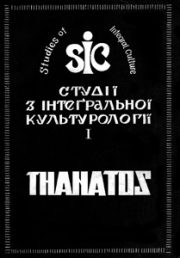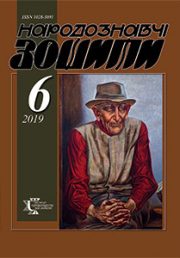The Ethnology Notebooks. 2021. № 3 (159), 543—554
UDK 930.2:398.341-035.3(477.83+477.85/.87=161.2)
DOI https://doi.org/10.15407/nz2021.03.543
CHEST AND TABLE IN THE TRADITIONAL RITUALS OF UKRAINIAN MOUNTAINS
HOSHCHITSKA Tetiana
- ORCID ID: https://orcid.org/0000-0001-8596-8974
- Candidate of Historical Sciences,
- Doctor of Philosophy, researcher fellow of department
- of Historical Ethnology of the Institute of Ethnology
- The National Academy of Sciences of Ukraine,
- 15, Svobody Avenue, 79000, Lviv, Ukraine,
- Contacts: e-mail: hoshchitska.tetiana@gmail.com
Abstract. Introduction: In the proposed exploration, the author aims to highlight the various beliefs and ideas associated with ancient objects of traditional furniture, which, however, have acquired important ritual significance during the performance of various rituals — a table and a chest.
Accordingly, the object of research is a complex of traditional rituals of the Ukrainians of the Carpathians, and the subject — beliefs and ideas associated with the chest and the table, as with the attributes of traditional rituals.
The main methods that were used are structural-functional, comparative and interdisciplinary. Scientific novelty: For the first time, various beliefs and ideas related to the chest and the table that are reflected in the traditional rituals of Ukrainian mountaineers are comprehensively analyzed, and the specifics of their existence in the traditional ritual culture are analyzed.
Results: The place that these objects occupied in the traditional consciousness of Ukrainian mountaineers has been studied. This is indicated in particular by the fact that it was used for festive meals, not for daily meals; a number of related bans; the fact that it was on the table (and not, for example, on the bench) that most ritually significant objects were made (for example, the baptismal «braid», the ceremonial wedding and construction tree); often the mountaineers were the first to bring the table into the newly built dwelling; a number of divinations were made here; it was the table that played an important role in the funeral rites and served as a place of a kind of «communication» with the afterlife; it is one of the few items of traditional furniture that appears in ceremonial folklore texts (and the image of the table is used to emphasize the solemnity, the unusualness of the celebrated action). Conclusion: In general, similar ideas existed in many Slavic ethnic groups, but in the Ukrainian Carpathians as a fairly isolated region with a specific history of settlement, they are preserved quite fully and contain many local features that significantly complement our ideas about ritual culture and the world of beliefs of Ukrainians in general.
Keywords: traditional rituals, Ukrainian Carpathians, beliefs related to housing, wooden furniture, chest, table.
Received 20.04.2021
REFERENCES
- Toporkov, A.L. (1990). Household utensils in the beliefs and rituals of Polesie. In: Ethnocultural traditions of the Russian rural population of the XIX—XX centuries. (Issue 2, pp. 66—118) [in Russian].
- Nadopta, A. (2020). Chest in the wedding ceremony of Ukrainians during the end of the XIXth century and the beginning of the XXth. The ethnology notebooks, 2, 323—329. DOI https://doi.org/10.15407/nz2020.02.323 [in Ukrainian].
- Huzij R. (2007) Folk tonatology: Carpathological investigations. Lviv: In-tut narodoznavstva NANU [in Ukrainian].
- Goshchitska, T. (2007) Field materials before topic of «Native arxitekture» from the expedition to the Starosambirs’kyj, Sambirs’kyj district, L’vivs’koi area, 16.06.—16.08.2007). In Archive of the IN NANU. F. 1. Оp. 2. Od. save 563. Arc. 1—146 [in Ukrainian].
- Stankevych, M. (2002). Ukrainian artistic tree XVI—XX s. Lviv: In-tut narodoznavstva NANU [in Ukrainian].
- Goshchitska, T. (2008). Field ethnographic materials on the theme «People’s construction», collected in the Skole district of Lviv region. In Archive of the IN NANU. F. 1. Оp. 2. Od. save 576. Arc. 1—72 [in Ukrainian].
- Vasilechko, L. (2003). Paths of echo. Ivano-Frankivsk [in Ukrainian].
- Koval, J. (1993). Poems are white, poems are «gray», prose and all sorts of things by Yaroslav Koval from Tsineva. Tsineva: National Museum in Tsineva [in Ukrainian].
- Vasylechko, L. (2009). Chronicle of Tsineva. Past and present. Lviv [in Ukrainian].
- Mysevych, O. (1937). Ukrainian wedding ceremony in Boykivshchyna. Lviv [in Ukrainian].
- Gritza, O. (Ed.). (1972). Ukrainian folk songs from the Lemik region. Kyiv: Musical Ukraine [in Ukrainian].
- Toporkov, A.L. (1995). Table. Slavic antiquities: Ethno linguistic dictionary (Vol. 5, pр. 165—169). Moscow: Mezhdunarodnyye otnosheniya [in Russian].
- Buhera, I.(1939). Customs and beliefs of Lemkivshchyna. Lviv [in Ukrainian].
- Krasykov, M. (2015). The death of death (before the understanding of Ukrainian national thanatology). In Folk culture of Ukrainians: life cycle of people. Age. Death. Culture of worshiping the dead (Vol. 5, pp. 173—206). Kyiv: Duliby [in Ukrainian].
- Radovych, R. (2019). Interior of Pokuttia housing (second half of the XIX — beginning of the XX century). The ethnology notebooks, 3, 715—731. DOI https://doi.org/10.15407/nz2019.03.715 [in Ukrainian].
- Voitovich, N. (2015). Folk Demonology of Boykivshchyna. Lviv [in Ukrainian].
- Shekeryk-Donnykiv, P. (2009). The year in beliefs of Hutsuls. Verkhovyna [in Ukrainian].
- Kmit, Yu. (1935). More about Volosatyj. In Litopys Bojkivschyny: zapysky prysviacheni doslidam istorii, kul’tury i pobutu bojkivs’koho plemeni (Vol. V, part 6, pp. 1—8) [in Ukrainian].
- Nykorak, O. (2003). Traditional fabrics in the customs and rites of Ukrainians. Bulletin of Lviv University. The series is historical (Issue 38, pp. 543—567) [in Ukrainian].
- Franko, I. (1898) Popular beliefs in Pidhiria. Etnohrafichnyj zbirnyk (Vol. V, pp. 160—218) [in Ukrainian].
- Shukhevych, V. (1904). Hutsulschyna. In: Materialy z ukrains’korus’koi etnolohii (Vol. VII, pp. 1—272) [in Ukrainian].
- Miloradovich, V.P. (1991). Life and life of the Lubensk peasant. In: Ukrainians: folk beliefs, superstitions, demonology (Pр. 170—341). Kyiv: Lybid [in Russian].
- Lintour, P. (Ed.). (1969). Dido-omniscient. Transcarpathian folk tales. Uzhhorod: Carpathians [in Ukrainian].
- Kosmeda, T.A, & Osipova, T.F. (2010). Communicative code of Ukrainians in paremias: a new type of explanatory dictionary. Drogobych [in Ukrainian].
- Digital archiv SHKR «Tustan». Оd. save 136. F. 25 (Photographs by Ivan Shveda) [in Ukrainian].
- Gayova, E. (2011). Philosophy of life in Lemko winter rites and customs (Christmas, Basil, «Babyn’s Holy Evening», John the Baptist, the Lord’s Supper) on expedition materials collected in the Velykobereznyansky district of the Transcarpathian region. In: Calendar rituals in the life of the ethnos. Collection of scientific works. Proceedings of the international scientific conference «Odessa ethnographic readings» (Pp. 65—74). Odessa [in Ukrainian].
- Bogatyrev, P.G.(1971). Magicacts, rites and beliefsinTranscarpathia. In Questions of the theory of popular art (Pp. 167—296). Моscow: Art [in Russian].
- Goshko, Yu.G. (1976). Population of the Ukrainian Carpathians of the XV—XVIII centuries. Settlement. Migration. Everyday life. Kyiv: Naukova dumka [in Ukrainian].
- Zdoroveha, N.I., & Utrysko, M. (1988). Folk customs and rites in Boykivshchyna. In Litopys Bojkivschyny, II, 48—54 [in Ukrainian].
- Kuziv, I. (1889). The life and customs of the mountain people. The Zoria: pys’mo lyteraturno-naukove dlia ruskykh’ rodyn’, 21, 351—352 [in Ukrainian].
- Ganus, D.M. (2015). A child in the system of folk beliefs and rituals of the population of the Ukrainian-Polish border (Dissertation). Ivan Krypiakevych Institute of Ukrainian Studies of the National Academy of Sciences of Ukraine [in Ukrainian].
- Zelenin, D.K. (1991). East Slavic ethnography. Моscow: Nauka [in Russian].
- Bezlichko, Yu. (Ed.). (1970). Ukrainian folk wedding in the works of Ukrainian, Russian and Polish fine arts of the XVIII—XIX centuries. Album. Kyiv: Art [in Ukrainian].
- Pankiv, M. (2000). Wedding in the village of Verbivtsi in the Horodenkiv region. Ivano-Frankivsk [in Ukrainian].
- Levkievskaya, E.E. (2002). Slavic amulet. Semantics and structure. Моscow: Indrik [in Russian].
- Svitluk, P.M. (2008). Heavenly Well: Transcarpathian folk traditions, legends, beliefs, customs, traditions and life. Uzhhorod: Grazda [in Ukrainian].
- Schnaider, J. (1906). People of Pechenizhyn. Lud, XII, 277—309 [in Polish].
- Huzij, R., Varkhol, J., Varkhol, N., & Ostapyk, O. (2002). Wedding ceremonies. In Lemkivschyna (Vol. 2, pp. 75—93). Lviv: In-tut narodoznavstva NANU [in Ukrainian].
- Maierchyk, M. (2006). Between areal parallels in the rites of the family cycle. In Ethnogenesis and ethnic history of the Ukrainian Carpathians (Vol. 2, pp. 558—568). Lviv: In-tut narodoznavstva NANU [in Ukrainian].
- Huzij, R., Varkhol, J., & Varkhol, N. (2002). Funerals ceremonies. In Lemkivschyna (Vol. 2, pp. 94—109). Lviv: In-tut narodoznavstva NANU [in Ukrainian].
- Musianovych, A. (1912). Funerals customs and ceremonies in villages Vizhomly, Yavorivs’koho pov. Etnohrafichnyj zbirnyk (Vol. ХXXI—XXXII, pp. 379—384) [in Ukrainian].
- Schnajder, J. (1910). People of Pechenizhyn. Lud (Vol. ХIII, pp. 21—33) [in Polish].
- Hoschits’ka, T. (2010). Rituals in the process of housing construction (based on field materials collected on the Boyko-Pidhirtsi border). Science. Religion. Society, 2, 8—12 [in Ukrainian].
- Cherleniak (Kerechanyn), I. (2018). Protective action for alive and magik action connected with the birial of the deceased of the Transcarpatian Ukrainians. The ethnology notebooks, 3, 662—670 [in Ukrainian].
- Vincent, S. (2011). On a high mountain. Ivano-Frankivsk: Lileja-NV [in Ukrainian].
- Rakhno, K. (2019). Pottery in the folklore heritage of Ivan Franko. The ethnology notebooks, 3, 563—579 [in Ukrainian].
- Halaychuk, V. (2010). From the Spiritual Culture of Bohorodchany Region: Customs, Beliefs and Legends Related to the Conceptual Representation of Death and the Dead. Mythology and Folklore, 3—4 (7), 27—49 [in Ukrainian].
- Potushniak, F. (1941). Suicides in the People’s Faith Lyteraturno-naukova pryloha karpatskoj nedili (Vol. 2, р. 1, 31) [in Ukrainian].
- Sokil, V., & Sokil, H. (1998). Folklore materials from the fatherland. Lviv [in Ukrainian].
- Shukhevych, V. (1904). Hutsul’schyna. In: Materialy z ukrains’korus’koi etnolohii (Vol. VII, pp. 1—272) [in Ukrainian].
- Bryniak, O. (2011). Rudiments of mythological beliefs in maternity rites and baptismal poetry of Ukrainians. The ethnology notebooks, 3, 426—435 [in Ukrainian].
- Shukhevych, V. (1902). Hutsul’schyna. In: Materialy z ukrains’korus’koi etnolohii (Vol. VII, pp. 1— 300) [in Ukrainian].
- Yatsenko, M. (Ed.). (1971). Ukrainian folk songs recorded by Volodymyr Hnatyuk. Kyiv: Musical Ukraine [in Ukrainian].
- (2011). From a parent source. To the anniversary of the comprehensive school I—III centuries, the village of Pidgorodtzi, Skole district, Lviv region. Lviv: Podgorodtzi [in Ukrainian].
- Ivanytsky, A.I. (Ed.). (2013). Songs from families and baptisms (collection-reconstruction with theoretical exploration, comments, models of rhythmic structure, indexes). Vinnytsia: New Book [in Ukrainian].
- Kaindl, R. (1898). Folklore materials from the collection of Prof. Raymond Kaindl. Ethnographic collection (Vol. V, pp. 141—159) [in Ukrainian].







